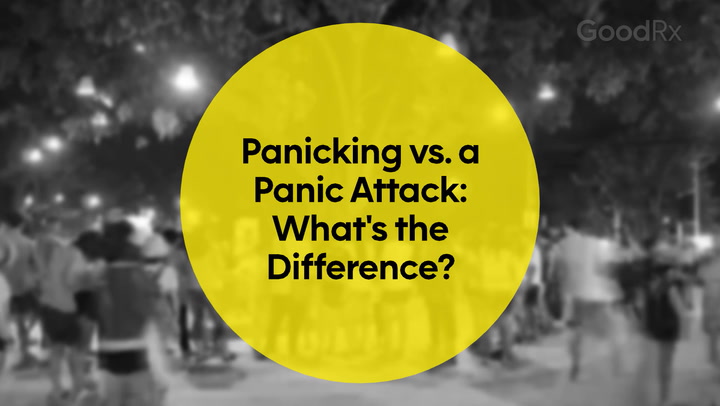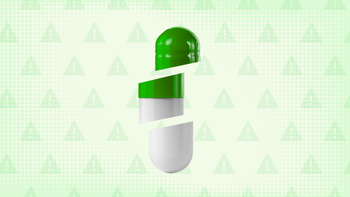
GoodRx Guide
Panic Disorder: Your GoodRx Guide
Comprehensive information for you or a loved one — including treatment options and discounts on popular medications.What is panic disorder?
Panic disorder is a type of anxiety disorder where you have recurring panic attacks. Panic attacks are episodes of sudden fear and discomfort. They can feel scary and intense — even though you may not truly be in danger. Panic attacks can also cause physical symptoms, like chest pain and shortness of breath.
If you have panic disorder, you may feel like your panic attacks are taking over your life. They can get in the way of work, school, daily activities, and personal relationships. Some people with panic disorder even avoid leaving their home because they are so worried about having an attack in public.
What causes panic disorder?
We don’t know exactly what causes panic disorder. It may be a combination of:
How your brain functions
Your life experiences
Your family history (genetics)
Your environment
Here’s what we do know about who gets panic disorder:
Panic disorder is more common in women than men.
Panic disorder usually starts in your late teens or early adulthood, but you can get it at any age.
Panic disorder can sometimes start when you’re under a lot of stress or going through a major life change.
Panic disorder can be associated with different medical conditions, like heart disease and thyroid problems.
Panic disorder can run in families.
Panic disorder symptoms
People with panic disorder have recurring, unexpected panic attacks. A panic attack usually starts suddenly, without warning. But it can also start when you are already feeling anxious.
During the attack, you feel overwhelmed with fear and discomfort. You also have at least four of the following symptoms:
Your heart starts to beat irregularly or more quickly.
You start to sweat.
You tremble or shake.
You feel like you can’t breathe or can’t get enough air.
You feel like you are choking.
Your chest feels painful and tight.
Your stomach hurts, or you feel like you might throw up.
You feel dizzy or lightheaded.
Your body feels chilled or overheated.
You feel numbness or tingling sensations.
You feel detached from yourself and your surroundings.
You’re scared that you are “going crazy” or losing control.
You’re scared that you are dying.
During the attack, these symptoms build up and peak in a few minutes. The attack usually lasts up to 20 minutes before the symptoms slowly go away.

How is panic disorder diagnosed?
Having a panic attack doesn’t necessarily mean you have panic disorder. To be diagnosed with panic disorder, you need to have recurring panic attacks and:
Be worried or anxious for at least a month about having more panic attacks in the future
Made changes in your life because of panic attacks (like avoiding certain places, not going out of your house, or not exercising)
Have ongoing concern you’re going to have another panic attack.
Your panic attacks aren’t due to another medical or mental health condition
If you’re worried about panic disorder, talk to your healthcare provider. They will ask about your symptoms and can help determine whether or not you have panic disorder. Your provider might also suggest you also see a mental health professional — either for further evaluation or to start therapy.
In some cases, your provider might also order lab tests. These tests can’t diagnose panic disorder. But they can rule out physical causes for your symptoms, like high thyroid levels.
Medications for panic disorder
Medications and therapy are both good treatments for panic disorder — either separately or together.
Antidepressant medications: These are the first-choice medications for treating panic disorder. When taken daily, they can help keep your symptoms under control. They can also help you to function better in your daily life.
Benzodiazepines: These are anti-anxiety medications that can help control your panic attacks. They can be used on their own or together with antidepressants. Benzodiazepines work best for panic disorder when they’re taken on a regular schedule. They’re not a good choice for people with a mood disorder or a substance use disorder.
Gabapentin: This is an anti-seizure medication that can be helpful for some people with panic disorder. It’s usually only used if antidepressants or benzodiazepines haven’t worked.
Therapy and other panic disorder treatments
Psychotherapy is an effective treatment for panic disorder, with or without medication. Therapy can help you:
Feel less shame and fear about having panic attacks
Understand your thinking patterns, feelings, and actions
Learn new skills for preventing and managing panic attacks
The two types of therapy with the best evidence for panic disorder are:
Cognitive-behavioral therapy (CBT): CBT can help you understand and change your feelings, thoughts, and behaviors related to panic attacks. CBT for panic can be done 1-on-1, in a group, or on your own (using an app or a workbook). Ten to 15 weekly therapy sessions are usually enough to have long-term benefits.
Panic-focused psychodynamic psychotherapy (PFPP): PFPP can help you understand your panic attacks and function better in your life overall. Compared to CBT, there’s less evidence to support PFPP — but it may work well for you. PFPP is a short-term therapy, usually lasting 2 to 3 months.
In addition to psychotherapy, there’s an FDA-approved device for panic attacks called Freespira. Freespira is a 28-day breathing training program, done under professional guidance.
Managing panic attacks at home
Living with panic attacks can be challenging. In addition to therapy and medications, self-care strategies can help you feel more in control of your life.
Here are some ideas that can help:
Learn and use breathing techniques and other relaxation techniques.
Create a coping tool kit to keep with you.
Talk to friends and family about your condition
Go to a support group, either in person or online.
Educate yourself about your body and the fight-flight-freeze response.
Build a support network.
Cut down on alcohol and caffeine.
Exercise.
Get enough good-quality sleep.
And remember: Even though panic attacks are disruptive, uncomfortable, and scary, they will always pass. You cannot die from a panic attack.
Common concerns
No. Panic disorder is a type of anxiety disorder, but it is different from general anxiety. You can read more about generalized anxiety disorder in this guide from GoodRx.
Panic attacks can occur as part of other anxiety disorders as well, such as agoraphobia.
No. Having a panic attack doesn’t mean you have (or will ever get) panic disorder. A panic attack is a single isolated event. You may even have occasional panic attacks, but that’s still not the same. People with panic disorder have repeated panic attacks to the point where it starts to affect their daily life.
Though there’s no cure for panic disorder, most people get better with treatment. Working with a healthcare provider or therapist can help you gain control over your panic attacks and manage them if they do occur.
References
American Psychiatric Association. (2009). Treating panic disorder: A quick reference guide.
Batelaan, N. M., et al. (2010). The 2-year prognosis of panic episodes in the general population. Psychological Medicine.
Busch, F., et al. (2008). Panic-focused psychodynamic psychotherapy. Psychiatric Times.
Freespira. (n.d.). Freespira.
Garakani, A., et al. (2020). Pharmacotherapy of anxiety disorders: Current and emerging treatment options. Frontiers in Psychiatry.
Ham, P., et al. (2005). Treatment of panic disorder. American Family Physician.
Liu, D. (n.d.). Anxiety disorders: Diagnosis & treatment.
Locke, A. B., et al. (2015). Diagnosis and management of generalized anxiety disorder and panic disorder in adults. American Family Physician.
MedlinePlus. (2021). Panic disorder.
National Health Service. (2020). Panic disorder.
National Institute of Mental Health. (2016). Panic disorder: When fear overwhelms.
Society of Clinical Psychology. (n.d.). Treatment: Cognitive-behavioral therapy for panic disorder.
Substance Abuse and Mental Health Services Administration. (2016). Table 3.10: Panic disorder and agoraphobia criteria changes from DSM-IV to DSM-5. Impact of the DSM-IV to DSM-5 Changes on the National Survey on Drug Use and Health.































